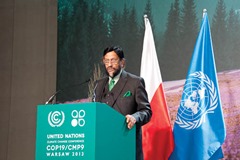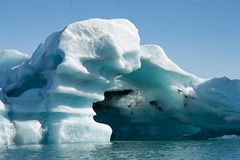The state of the climate
 Peter Cheney considers the main messages from the latest IPCC assessment of climate change and how it can be tackled more effectively.
Peter Cheney considers the main messages from the latest IPCC assessment of climate change and how it can be tackled more effectively.
Global attention has again focused on the wide-ranging nature of climate change and the need for action following the publication of the Intergovernmental Panel on Climate Change’s fifth assessment report. The IPCC is based in Geneva and has three themed working groups:
1. physical scientific aspects of the climate system and climate change;
2. vulnerability of socio-economic and natural systems; and
3. options for mitigation.
Their three reports have been combined to form the final report and all documentation, including academic comments, is available at www.ipcc.ch
Science
The physical science group reported in January and found that the 1983-2012 period was likely to have been the warmest period of that length in the last 1,400 years. It was “virtually certain” that upper ocean waters (0-700m in depth) had been warming since 1971.
Authors expressed a “high confidence” that ice mass was being lost from the Greenland and Antarctic ice sheets, Arctic sea ice, Northern Hemisphere spring snow cover, and almost all glaciers.
Global sea levels rose by 0.19m between 1901 and 2010. Carbon dioxide concentrations had increased by 40 per cent since pre-industrial times but about 30 per cent of man-made emissions had been absorbed by the ocean, causing acidification.
However, temporary cooling follows large volcanic eruptions which obscure the Sun and increase the Earth’s albedo. The most recent ‘volcanic winter’ took place in the early 1990s after the eruption of Mount Pinatubo in the Philippines.
Limiting future climate change will require “substantial and sustained reductions” of greenhouse gas emissions. Most scenarios projected that global surface temperature would rise by at least 1.5°C by 2100, compared to 1850-1900 levels, although some expected the rise to be over 2°C.
The contrast in precipitation between wet and dry regions and between wet and dry seasons would increase, with drought increasing around most of the Equator. Climate change could affect ocean circulation if heating reached down into the deep ocean but “no abrupt transition or collapse” is foreseen in the 21st century.
Reductions in snow and ice cover – and the consequent rises in sea level – are expected to continue. Importantly, most of the aspects of climate change “will persist for many centuries even if emissions of CO2 are stopped.”
The second group’s report has a new focus on assessing risk, which can be interpreted differently by different governments and societies. This is meant to give policy-makers more flexibility as they consider their response.
In many regions, changes in precipitation and snow and ice cover are altering how hydrological systems work. Many species, whether land-based or water-based, are changing their ranges and seasonal activities as the climate changes.
Wheat and maize yields in low latitude regions have fallen but rice and soybean yields are less affected. Poor harvests are leading to rapid food and cereal price increases.
The impact on human health is “not well quantified” but there is a medium confidence that climate change has increased heat-related mortality and reduced cold-related mortality in some regions. The most obvious risk was that of death, injury, illness or disruption in low-lying coastal zones and small island developing countries. Other risks include:
• the extinction of many plant and animal species which cannot adapt quickly enough to change;
• reduced surface water and groundwater resources;
• forest dieback, which limits the natural ability to store carbon;
• damaged polar ecosystems and coral reefs (due to acidification); and
• increased poverty, refugee movements and conflict.
Adaptation is place- and context-specific but some general principles can be applied e.g. better co-ordination across society, dealing with present problems before turning to those expected in the future, using local knowledge, and recognising that poor adaptation can increase the risks faced by communities.
The authors of the third report emphasised that mitigation is still possible, either by reducing the sources or enhancing the sinks for carbon emissions. However, effective mitigation will not be achieved if “individual agents advance their own interests independently”. Climate change has to be seen as “a collective action problem at the global scale”. If developed countries contribute a fair share towards mitigation, this can make co-operation more effective.
Climate change policy has a cross-cutting impact on other policy areas such as health, agriculture and energy. It often deals with low probability events which would have a devastating impact if they did occur.
Economic and population growth are still the most important global drivers of fossil fuel-related emissions, with economic growth becoming increasingly important over the last decade. Without additional mitigation, the global mean surface temperature could rise by 3.7-4.8°C by 2100 compared to pre-industrial levels.
The level of atmosphere CO2 has now passed 400ppm and limiting that concentration to 450ppm by 2100 would involve “large-scale changes” in energy systems and potentially land use over the next 30 years. Estimates of the economic costs of mitigation “vary widely” but the IPCC puts forward figures for a standard scenario where all countries began mitigation immediately, with a single global carbon price and using all available technologies.
Under this scenario, global consumption would fall by 1.7 per cent in 2030, 3.4 per cent in 2050 and 4.8 per cent in 2100 (median figures) compared to expected baselines.
Changing energy
Energy-related carbon emissions will double or even triple by 2050 unless more is done to improve energy efficiency. A growing number of renewable technologies are reaching maturity. Nuclear power is already well-established and could make an “increasing contribution” to low carbon energy but operational risks and public fears hold it back.
A significant reduction in emissions could be achieved by replacing coal-fired plants with combined cycle gas plants and combined heat and power plants.
Transport emissions are also expected to double by 2050. Final energy demand in that year could be reduced by 40 per cent if planned energy efficiency and vehicle performance improvements are backed up by high speed rail and a “more compact” city shape which allows for more walking and cycling.
Building-related emissions may double or triple due to economic growth – and once a building is built, it is hard to change its performance. One solution may involve incorporating traditional architectural styles into buildings in developing countries rather than simply adopting Western templates. Energy efficiency is affirmed as having a key role in reducing industry’s carbon footprint.
The most effective mitigation policies in land use are afforestation (along with less deforestation), better cropland and grazing land management and restoring organic soils.
Fifty-two per cent of the world’s population now lives in urban areas and this may rise to 69 per cent by 2050. The next two decades therefore “present a window of opportunity” for mitigation in urban areas and most of this growth will take place in small and medium-sized cities in developing countries. Effective policies include co-locating high density housing and high density employment and making public transport more available.
Key responses
“It is finally dawning on people that this is a matter of exceptional importance,” Taoiseach Enda Kenny stated when answering Dáil questions about the latest report. “Clearly when one looks at weather patterns all over the world, one can see the changing nature of the ferocity of nature and its impact on water levels and human life in various parts of the world.”
Barack Obama’s climate advisor, John Holdren, commented that more international action now on curbing climate change and preparing for unavoidable impacts would mean “less suffering … inflicted on our communities and on our children and grandchildren.”
EU Climate Change Commissioner Connie Hedegaard concurred but called on the US and China to follow Europe’s example by setting long-term emissions reduction targets: “When will you, the big emitters, do the same? The more you wait, the more it will cost.” The Chinese Government made no official comment on the latest IPCC report but its official media outlets have broadly endorsed its findings.
Scenes by UN staff photographers Eskinder Debebe, Marco Dormino and Eva Fendiaspara.







